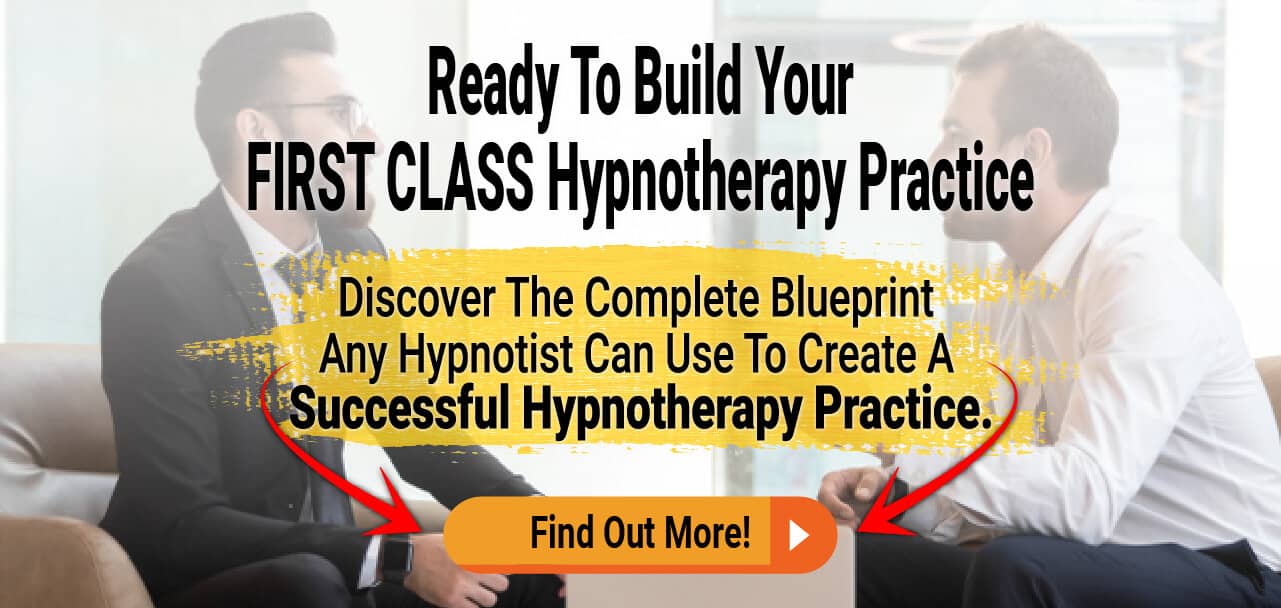
In the first part of this article, you learned about hypnosis and client attraction, specifically 3 techniques for attracting clients to your hypnosis business. Those techniques are socializing, client referrals, and professional referrals. The first two of these are really just to get things started. To play in the big league, you need to focus on getting professional referrals. Now, it’s time for you to discover how to win clients through the referral strategy.
Why? Because professional referrals will bring you a lot more clients (and possibly a steady stream of clients) than you can get in any other way.
And they’ll be the kinds of clients that really need your help.
If you can tap into this type of network, you’ll never have to worry about where you get your clients from ever again.
But how do you go about it?
Before finding that out, you need to discover the answers to two simple questions:
1. What is a referral?
2. How should it be done?
How To Win Clients Through The Referral Strategy

All this talk about referrals, but what does “referral” actually mean?
Here’s a basic but precise definition: a referral simply involves introducing someone you care about to someone or something you trust.
For instance, if you saw a movie and you really liked it, you might recommend it to a friend.
The same goes for a book you’ve read.
These are low-risk referrals because even if your friend doesn’t like them, they won’t hold it against you.
Even if they absolutely hate the movie or book.
But what about if you recommend a doctor? This carries a higher risk.
If they hate the doctor, it’s going to weaken your relationship.
They won’t be able to trust you in the same way anymore.
And that’s because books and movies are minor things. If they don’t turn you on, it’s no big deal. They’re not hugely important in the overall scheme of things.
But with doctors, it’s different. If the doctor fails your friend, then it will feel as if you failed them too.
So referrals carry an element of risk. The trick is to reverse the risk so that it’s riskier to not make the referral than it is to make it.
Referrals are recommendations that are driven by the desire to help people you care about.
Those people have a problem and you have the solution. Or someone you trust has the solution.
A genuine referral is actually good for the person making the referral. It allows them to help when they might personally be unable to, by referring someone who can.
For example, imagine that a close relative calls and tells you he’s got a leak somewhere. The house is slowly being flooded.
There’s no time to build an ark. However, by chance, you happen to know a reliable plumber that you trust, and you pass on his details.
Or perhaps you know someone who enjoys books about business, and specifically about marketing.
You’re not a marketing expert yourself, but you can recommend a book you’ve read that explains marketing inside and out.
And that’s a referral in a nutshell: introducing someone you care about (a relative or friend) to someone/something you trust (the plumber/book).
To sum up, making referrals or recommendations involves finding the answers to these questions:
- Who are you talking to?
- What do they need?
- What problem are they facing?
- What do you have that can solve their problem?
- Why should they be willing to spend the time and energy required to make that happen?
Another way to learn more about referrals is to interview people about the recommendations they make.
How and why do they make them?
This will give you an additional insight into how referrals work and how you can use that information to your advantage.
But knowing that, how can you apply it to start getting those referrals?
Hypnosis & Client Attraction: Using The Virtual Referral Formula

When it comes to hypnosis and client attraction, the key to success is acquiring lots of referrals.
So wouldn’t it be great if you could ask for referrals without sounding like you’re begging?
The virtual referral formula enables you to do just that. In fact, it will let you do everything required to get a referral without actually asking for one.
There are four steps to the virtual referral formula, which are as follows:
1. Warm-up
This is basically a revivification of success. The idea is to ask your clients if they’ve enjoyed the work that you’ve done together so far. If they say that they have, try to get more detail. Ask them why, and then what they think the highlights were.
That’s in a professional setting, of course. In a more casual environment, you might simply be having a conversation with someone. The more meaningful the conversation, the better. Again you can ask them if they enjoyed the conversation and perhaps which bits they got the most out of.
What you’re doing is revivifying the things that went well, helping the client or prospective client to see the value in what you can offer them.
2. Social probe
This involves finding out what your clients’ (or prospective clients’) friends are like. You want to find out if they know any other people who have the same types of problems or issues. Start by asking them who they know that might benefit from a similar type of conversation.
To find out if their friend might be someone you want to work with, you need to dig deeper. Ask them what their friend is like, and what things they appreciate about them. Then ask them what you would appreciate about them.
This last question forces the person you’re talking with to mentally rehearse a meeting between you and their friend.
3. Indirect introduction
This next step involves connecting virtually to a friend of a client. You can start by asking what their friend would like about having a conversation with you, what they would enjoy about working with you, and what they might get out of it.
Next, you could ask how comfortable the person would feel introducing their friend to you. You’re not asking for an introduction, you’re just asking about their comfort level.
You’re giving the other person lots of opportunities to imagine a time when you and his friend meet without putting any pressure on him.
Finally, you say that it sounds like you and the person’s friend would probably hit it off. If you got together, good things would happen for the friend.
4. Logistics
This involves working out how to arrange the introduction to the person’s friend. The best way to achieve this is to negotiate the introduction.
You can do that by asking the person what they think is the best way for you and their friend to enter a conversation. The person might recommend a few possibilities, such as:
a. Setting up a three-way phone call
b. A three-way meeting in person
c. Inviting the friend to an event you will be attending
Hopefully, by this point, the person will have agreed that it will be valuable for their friend to meet you. The person will also know that you will be grateful to them for their help. You will feel good getting another social contact, and the other person will feel good knowing they’ve helped you and their friend.
It’s a win-win all around.
The virtual referral formula works with everyone including doctors, corporations, individuals, ex-clients and so on. However, working with doctors and healthcare professionals requires a different relationship.
Building trust with a doctor will be different from building trust with a client. But since doctors trust research, you can provide reams of research and studies into hypnosis proving how effective it really is.
The only reason a doctor might not recommend you as a hypnotist is if they don’t trust you. You can avoid that happening by being professional at all times, building a better relationship, and providing proof of what hypnosis can do in the form of quality research and articles.
Where To Look For Professional Referrals

As well as doctors, there are other professions you can tap into for referrals.
An article on the Wellness Institute blog lists a number of professional bodies that would make good referral sources, including:
- Attorneys – they may have clients suffering from mental health problems following a recent trauma, a car accident, a divorce, etc.
- Dentists – they may have patients who are unable to relax or who experience panic attacks before or during dental work
- Massage therapists – they may have clients who find it hard to relax or who are unable to tolerate human touch
These are all problems that can be alleviated using hypnosis. With any luck, one or two success stories will be enough to keep the referrals coming.
And when these referred individuals become clients, then you’ve got another stream of people to work your virtual referral formula on. Before long you should have more clients than you know what to do with and will be using your hypnosis skills as a force for good on as many people as possible.
If you haven’t read the first part of our hypnosis and client attraction series, here it is: Hypnosis And Client Attraction Part 1: Be Equipped With These Professional Tools To Attract Clients
Conclusion & Takeaways
The best way to win clients for your hypnosis business is with a referral strategy.
A referral is the act of introducing someone you care about to someone or something you trust.
Another word for a referral is a recommendation.
There are low-level recommendations that carry a low risk, and high-level recommendations that carry a higher risk.
For example, if you recommend a book or a movie to someone and they don’t like it, they’ll still be your friend. They’ll still trust you although maybe not agree with your taste in certain things.
If you recommend a doctor and they don’t like it, the risk to your relationship is much bigger and could result in them not trusting you anymore.
To make referrals you need to find the answers to these questions:
- Who are you talking to?
- What do they need?
- What problem are they facing?
- What do you have that can solve their problem?
- Why should they be willing to spend the time and energy required to make that happen?
An easier way to get referrals involves using the virtual referral formula. This formula has four steps, which are:
1. Warm up – the idea is to ask your clients if they’ve enjoyed the work that you’ve done together so far. If they have, perhaps their friend(s) would also benefit from meeting you.
2. Social probe – this involves finding out what your clients’ friends are like, especially those with similar types of problems. The idea is to get your client to mentally rehearse a meeting with you and their friend.
3. Indirect introduction – this step involves connecting virtually to a friend of a client by asking what their friend would like about having a conversation with you, what they would enjoy about working with you, and what they might get out of it.
4. Logistics – this involves working out how to arrange an introduction to the person’s friend. Simply ask the person what they think is the best way for you and their friend to have a conversation.
The virtual referral formula works with everyone including doctors, corporations, individuals and ex-clients.
Building trust with a doctor or health worker requires a different approach. You need to be totally professional and provide as much research-based evidence of the effectiveness of hypnosis as possible, citing studies that prove it works.
Other professions where you might source referrals include attorneys, dentists, massage therapists and others who deal with clients suffering from mental health issues such as panic, PTSD, trauma and so on.










![Yogic Breathing For Hypnosis: 3 Easy Techniques To Ground & Relax Your Clients Before Inducing A Hypnotic Trance [Includes Infographic] Yogic Breathing For Hypnosis: 3 Easy Techniques To Ground & Relax Your Clients Before Inducing A Hypnotic Trance [Includes Infographic]](https://hypnosistrainingacademy.com/wp-content/uploads/2019/05/yogic-breathing-for-hypnosis.jpg)


![[ADVANCED GUIDE] How To Master Hypnotic Regression Therapy - Part I: Essential Principles To Profoundly Transform Your Subject’s Emotional Trauma [ADVANCED GUIDE] How To Master Hypnotic Regression Therapy - Part I: Essential Principles To Profoundly Transform Your Subject’s Emotional Trauma](https://hypnosistrainingacademy.com/wp-content/uploads/2016/09/hypnotic-regression-therapy-essential-principles.jpg)

